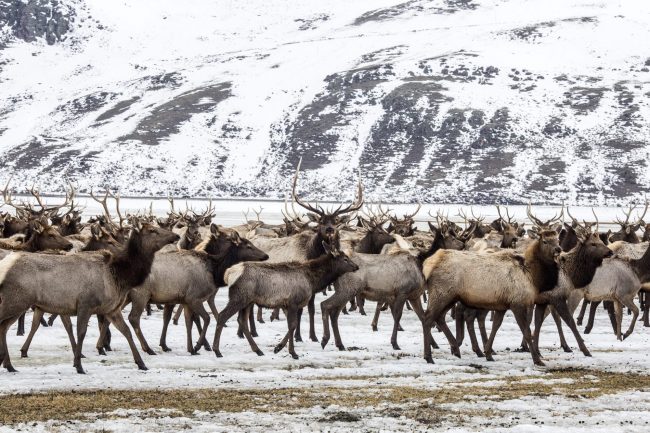CHEYENNE, Wyo. – Add this to the long list of problems caused by buzzing drones: Frightening 1,500 elk into stampeding at a time of year when too much stress can be deadly for the animals.

This winter already is one for the books in western Wyoming. More than twice as much snowfall than usual has fallen in many areas, and more than 3 feet has accumulated at the National Elk Refuge in the scenic valley of Jackson Hole.
Typically the National Elk Refuge provides a winter haven for elk. But on Monday, David A. Smart, 45, of Washington, D.C., got a $280 ticket for allegedly launching a drone from a highway pullout and flying it over hundreds of elk resting there.
READ MORE: Caught on camera: Police dashcam captures sudden collision with elk
The device caused the elk to stampede half a mile through the snow. Smart was trying to film the animals and afterward was apologetic, refuge deputy manager Cris Dippel said Friday.
Nonetheless, wildlife managers take animal harassment seriously. The federal crime of which Smart was accused, disturbing wildlife, is punishable by an up to $5,000 fine.

Get breaking National news
The deep snow is a bane for animals, including bison hit by vehicles as they sought easier walking along plowed roads.
READ MORE: Cow elk shot; resident says aboriginal hunters were trespassing
Elk, moose, mule deer and antelope fatten up during green months so when winter hits they can subsist on less-nourishing forage often covered up by snow and ice.
“It’s a crucial time of year for those animals and they don’t need to be burning up additional energy stores unnecessarily,” said Doug Brimeyer, deputy wildlife division chief at the Wyoming Game and Fish Department.
Wyoming has several laws and regulations against harassing wildlife, including one that prohibits antler collecting during winter and part of the spring. Bull elk drop their antlers during late winter and early spring and too many avid antler collectors scaring elk with their snowmobiles prompted that state regulation in 2009.
READ MORE: Calgary drone captures osprey eating dinner on a power pole
At the refuge, wildlife managers put out alfalfa pellets and other feed to help elk and bison survive the winter, a practice environmentalists worry could encourage disease.
Chronic wasting disease, a contagious neurological disease that causes elk and deer to lose weight and eventually die, has been slowly spreading into western Wyoming over the years.
“The concern is if it is found on those feedgrounds, it could be exacerbated by the elk concentrated in those areas,” said Chris Colligan with the Greater Yellowstone Coalition. “It’s slowly creeping toward our fed elk populations.”
The state operates 22 other elk feedgrounds in western Wyoming. They serve to keep elk numbers up not just for the animals’ sake but for the benefit of hunters and the millions of tourists who flock to the region every summer.
“Anything we can do to afford those animals an edge to help them survive is pretty critical,” said Brimeyer.







Comments